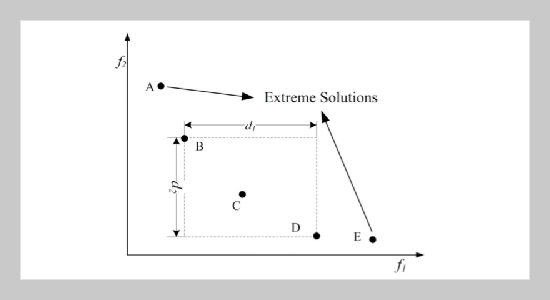REFERENCES
- [1] Venkata Rao, R. and Patel, V., “Multi-objective Optimization of Heat Exchangers Using a Modified Teaching-learning-based Optimization Algorithm,” Applied Mathematical Modelling, Vol. 37, No. 3, pp. 1147� 1162 (2012). doi: 10.1016/j.apm.2012.03.043
- [2] Pasupathy, T., Rajendran, C. and Suresh, R. K., “A Multi-objective Genetic Algorithm for Scheduling in Flow Shops to Minimizethe Makespan and Total Flow Time of Jobs,” The International Journal of Advanced Manufacturing Technology,Vol.27, No. 7�8, pp. 804� 815 (2006). doi: 10.1007/s00170-004-2249-6
- [3] Jamshidi, R., Fatemi Ghomi, S. M. T. and Karimi, B., “Multi-objective Green Supply Chain Optimization with a New Hybrid Memetic Algorithm Using the Taguchi Method,” Scientia Iranica, Vol. 19, No. 6, pp. 1876�1886 (2012). doi: 10.1016/j.scient.2012.07.002
- [4] Horn, J., Nafpliotis, N. and Goldberg, D. E., “A Niched Pareto Genetic Algorithm for Multiobjective Optimization,” IEEE World Congress on Computational Intelligence, Proceedings of the First IEEE Conference on Evolutionary Computation, Orlando, FL, USA, June 27�29, Vol. 1, pp. 82�87 (1994). doi: 10.1109/ICEC. 1994.350037
- [5] Zitzler, E. and Thiele, L., “Multiobjective Evolutionary Algorithms: a Comparative Case Study and the Strength Pareto Approach,” IEEE Transactions on Evolutionary Computation, Vol. 3, No. 4, pp. 257�271 (1999). doi: 10.1109/4235.797969
- [6] Knowles, J. and Corne, D., “The Pareto Archived Evolution Strategy: a New Baseline Algorithm for Pareto Multiobjective Optimisation,” Proceedings of the 1999 Congress on Evolutionary Computation, Washington, DC, USA, July 6�9, Vol. 1, pp. 98�105 (1999).
- [7] Deb, K., Agrawal, S., Pratap, A. and Meyarivan, T., “A Fast Elitist Non-dominated Sorting Genetic Algorithm for Multi-objective Optimization: NSGA-II,” Lecture Notes in Computer Science, Vol. 1917, No. 2000, pp. 849�858 (2000). doi: 10.1007/3-540-45356-3_83
- [8] Zitzler,E.,Laumanns,M.,Thiele,L.,Zitzler,E.,Zitzler, E., Thiele, L. and Thiele, L., “SPEA2: Improving the Strength Pareto Evolutionary Algorithm,” Eidgenössische Technische Hochschule Zürich (ETH), Institut für Technische Informatik und Kommunikationsnetze (TIK) (2001). doi: 10.3929/ethz-a-004284029
- [9] Coello, C. A. C. C. and Pulido, G. T., “AMicro-genetic Algorithm for Multiobjective Optimization,” International Conference on Evolutionary Multi-Criterion Optimization, Zurich, Switzerland, Mar 7–9, pp. 126�140 (2001).
- [10] Zhang, Q. and Li, H., “MOEA/D: a Multiobjective Evolutionary Algorithm Based on Decomposition,” Evolutionary Computation, IEEE Transactions on, Vol. 11, No. 6, pp. 712�731 (2007).
- [11] Zhang, Q., Zhou, A. and Jin, Y., “RM-MEDA: a Regularity Model-based Multiobjective Estimation of Distribution Algorithm,”EvolutionaryComputation,IEEE Transactions on, Vol. 12, No. 1, pp. 41�63 (2008). doi: 10.1109/TEVC.2007.892759
- [12] Huang, V. L., Zhao, S. Z., Mallipeddi, R., Suganthan, P. N. and Ieee, “Multi-objective Optimization Using Self-adaptive Differential Evolution Algorithm,” IEEE Congress on Evolutionary Computation, Trondheim, Norway, May 18�21, pp. 190�194, (2009). doi: 10. 1109/CEC.2009.4982947
- [13] Atashpaz-Gargari, E. and Lucas, C., “Imperialist Competitive Algorithm: an Algorithm for Optimization Inspired by Imperialistic Competition,” IEEE Congress on Evolutionary Computation,Singapore, Sept.25�28, pp. 4661�4667 (2007). doi: 10.1109/CEC.2007.4425083
- [14] Poli,R.,Kennedy,J.andBlackwell,T.,“Particle Swarm Optimization,” Swarm Intelligence, Vol. 1, No. 1, pp. 33�57 (2007).
- [15] Karaboga, D. and Basturk, B., “A Powerful and Efficient Algorithm for Numerical Function Optimization: Artificial Bee Colony (ABC) Algorithm,” Journal of Global Optimization, Vol. 39, No. 3, pp. 459�471 (2007). doi: 10.1007/s10898-007-9149-x
- [16] Rao, R., Savsani, V. and Vakharia, D., “Teaching-learning-based Optimization: an Optimization Method for Continuous Non-linear Large Scale Problems,” Information Sciences, Vol. 183, No. 1, pp. 1�15 (2012). doi: 10.1016/j.ins.2011.08.006
- [17] Hedayatzadeh, R., Hasanizadeh, B., Akbari, R. and Ziarati, K., “A Multi-objective Artificial Bee Colony for Optimizing Multi-objective Problems,” 2010 3rd International Conference on Advanced Computer Theory and Engineering (ICACTE), Chengdu, China, Vol. 5, pp. V5-277�V5-281. doi: 10.1109/ICACTE.2010. 5579761
- [18] Ali, H. and Khan, F. A., “Attributed Multi-objective Comprehensive Learning Particle Swarm Optimization for Optimal Security of Networks,” Applied Soft Computing, Vol. 13, No. 9, pp. 3903�3921 (2013). doi: 10. 1016/j.asoc.2013.04.015
- [19] Zou, F., Wang, L., Hei, X., Chen, D. and Wang, B., “Multi-objective Optimization Using Teaching-learning-based Optimization Algorithm,” Engineering Applications of Artificial Intelligence, Vol. 26, No. 4, pp. 1291�1300 (2013). doi: 10.1016/j.engappai.2012.11. 006
- [20] Wolpert, D. H. and Macready, W. G., “No Free Lunch Theorems for Optimization,” Evolutionary Computation, IEEE Transactions on, Vol. 1, No. 1, pp. 67�82 (1997). doi: 10.1109/4235.585893
- [21] Rao, R., Savsani, V. and Vakharia, D., “Teaching–learning-based Optimization: a Novel Method for Constrained Mechanical Design Optimization Problems,” Computer-Aided Design, Vol. 43, No. 3, pp. 303�315 (2011). doi: 10.1016/j.cad.2010.12.015
- [22] Satapathy, S. C. and Naik, A., “Data Clustering Based on Teaching-learning-based Optimization,”SEMCCO 2011: Swarm, Evolutionary, and Memetic Computing, pp. 148�156: Springer (2011).
- [23] Venkata Rao, R. and Kalyankar, V., “Parameter Optimization of Modern Machining Processes Using Teaching–learning-based OptimizationAlgorithm,” Engineering Applications of Artificial Intelligence, Vol. 26, No. 1, pp. 524�531 (2012). doi: 10.1016/j.engappai2012.06.007
- [24] Deb, K., Pratap, A., Agarwal, S. and Meyarivan, T., “A Fast and Elitist Multiobjective Genetic Algorithm: NSGA-II,” IEEE Transactions on Evolutionary Computation, Vol. 6, No. 2, pp. 182�197 (2002). doi: 10. 1109/4235.996017
- [25] Van Veldhuizen, D. A. and Lamont, G. B., “Evolutionary Computation and Convergence to a Pareto Front,” Late Breaking Papers at the Genetic Programming 1998 Conference, pp. 221�228 (1998).
- [26] Schott, J. R., Fault Tolerant Design Using Single and Multicriteria Genetic Algorithm Optimization,Master’s Desertation, Massachusetts Institute of Technology, Cambridge, USA. (1995).
- [27] Deb, K., Multi-objective Optimization Using Evolutionary Algorithms, Wiley (2001). [28] Coello, C. A. C., Lamont, G. B. and Van Veldhuisen, D. A., Evolutionary Algorithms for Solving Multi-objective Problems, Springer (2007).
















